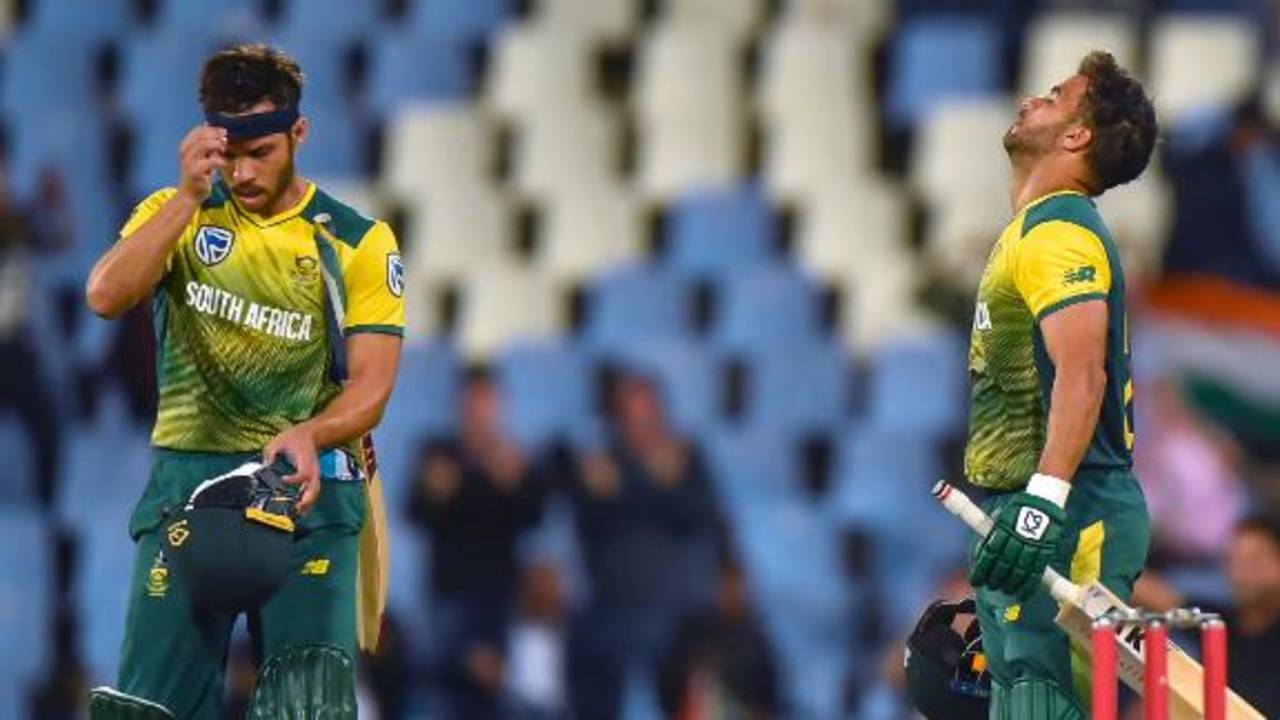This is a weird summer for South Africa. They have been losing ODIs at home to spin in dry conditions. The only limited-overs matches they have won have been in the rain. It is as if Duckworth-Lewis-Stern holds no demons for them until the next knockout match arrives. Well, South Africa actually did speak about this game being like a semi-final, a must win for them to take the series to Cape Town.
Jokes aside, this might have been the first time the lurking shadow of DLS might have actually helped South Africa direct a chase. Until the drizzle began at the start of the fifth over, the South Africa innings had lacked a bit of a purpose. Manish Pandey did say that the new ball was getting stuck in the surface, but still it seemed the innings was not going anywhere, especially with JJ Smuts not able to get out of the blocks.
And then, all of a sudden, South Africa had a target for the end of the fifth over. They needed to get 18 in this over to stay ahead of the DLS target should there be no more play. They lost a wicket in the process but rain continued, and the pair of
Heinrich Klaasen and JP Duminy kept batting to the DLS total. Klaasen hit two sixes in the next over, but South Africa were still five behind. The next over, with rain still coming down, ended with South Africa three behind. In the eighth over, Klaasen hit Yuzvendra Chahal for a six, taking them ahead of the DLS par score, and on cue, the rain stopped.
South Africa scored 46 in those four overs for the loss of one wicket, and Klaasen spoke about the impact of that period. "At the start, yes [we did bat to DLS targets]," Klaasen said. "I think credit must go to the umpires for keeping us out on the field. At some stage it actually drizzled quite hard. The first five or six overs, we actually tried to keep up with Duckworth-Lewis. Luckily on the fifth or the sixth over, the drizzle stopped. I said to JP, 'We can now actually stay one boundary under the Duckworth-Lewis target, and it worked out."
In the ninth and tenth overs, South Africa went back to waiting for a bad ball or one into their strong areas to hit a boundary. Earlier, they had the freedom to go for two boundaries, and they kept connecting. Klaasen even joked they might be on to something here. "Not really [it's not like every over is a last over]," Klaasen said. "It's small targets. I think the way we actually batted tonight, it's a good way to chase a total. Keep up with the rate, keep up with Duckworth-Lewis. That just gave us small targets. When to go, when not to go. Maybe something to think about going forward."
That there was a focus and some freedom is hard to argue against. "The way JP told me to go, 'This over needs to go for 10,'" Klaasen said, "it takes all the fear out of your game. Then it is very important to keep a calm head."
It all sounds great until here. It is the lack of extension of this principle into the first innings that perplexes analysts. Think of Duckworth and Lewis and Stern as three analysts. Their algorithm when chasing tells you where a team needs to be at certain stages to be considered ahead of the game. In a game that is heavily skewed against teams batting first, analysts wonder why batsmen can't go according to these small targets they set them based on various factors: history of the ground, history of the bowlers against this set of batsmen, chasing history of the opposition, and communication with the batsmen out in the middle as to what the conditions are like.
It is like letting the dugout - the coaches and the analysts - decide - based on communication with batsmen in the middle - what a good target is, and then giving the batsmen small DLS-like targets for each over or a set of two overs. It doesn't happen. It can happen in standardised conditions - perhaps Wanderers or Wankhede Stadium where the conditions rarely waver from the norm - but cricket, even over 20 overs, remains reliant on conditions.
ESPNcricinfo asked Stephen Fleming, one of the most successful T20 coaches going around, if this kind of thinking was realistic. "It is creating another pressure," Fleming said. "If they don't get it, they go with more anxiety into the next over. If they are three runs behind that, you have got to get that many more in the next. In a way, while setting a total, you are applying the pressure of a run chase. You are defeating the purpose of being as efficient as you can. If you are as efficient as you can be in the first innings, then you should make a good score."
In other words, if something must be done, it doesn't come with the fear of consequences of a failure. Also, cricket continues to be a sport where coaches are happy for players to be the boss. They trust the players to be able to do what the conditions and situations demand. And yet, some of the successful T20 captains are those who have come a long way from sniggering at match-ups and listening to analysts for certain field positions for certain batsmen. If the imbalance against sides batting first continues to stay, this might not be too outlandish an idea to try and see if it works.
Sidharth Monga is an assistant editor at ESPNcricinfo
